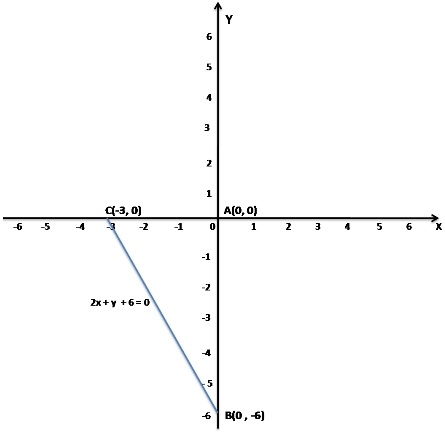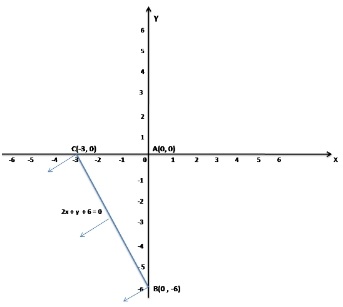Do you need some help in preparing for your upcoming Class 11 Maths exams? We’ve compiled a list of MCQ on Linear Inequalities Class 11 MCQs Questions with Answers to get you started with the subject. You can download NCERT MCQ Questions for Class 11 Maths Chapter 6 Linear Inequalities with Answers Pdf free download, and learn how smart students prepare well ahead with MCQ Questions for Class 11 Maths with Answers.
Linear Inequalities Class 11 MCQs Questions with Answers
Solving the MCQ Questions of Linear Inequalities Class 11 with answers can help you understand the concepts better.
Question 1.
If -2 < 2x – 1 < 2 then the value of x lies in the interval
(a) (1/2, 3/2)
(b) (-1/2, 3/2)
(c) (3/2, 1/2)
(d) (3/2, -1/2)
Answer
Answer: (b) (-1/2, 3/2)
Given, -2 < 2x – 1 < 2
⇒ -2 + 1 < 2x < 2 + 1
⇒ -1 < 2x < 3
⇒ -1/2 < x < 3/2
⇒ x ∈ (-1/2, 3/2)
Question 2.
If x² < -4 then the value of x is
(a) (-2, 2)
(b) (2, ∞)
(c) (-2, ∞)
(d) No solution
Answer
Answer: (d) No solution
Given, x² < -4
⇒ x² + 4 < 0
Which is not possible.
So, there is no solution.
Question 3.
If |x| < -5 then the value of x lies in the interval
(a) (-∞, -5)
(b) (∞, 5)
(c) (-5, ∞)
(d) No Solution
Answer
Answer: (d) No Solution
Given, |x| < -5
Now, LHS ≥ 0 and RHS < 0
Since LHS is non-negative and RHS is negative
So, |x| < -5 does not posses any solution
Question 4.
The graph of the inequations x ≤ 0 , y ≤ 0, and 2x + y + 6 ≥ 0 is
(a) exterior of a triangle
(b) a triangular region in the 3rd quadrant
(c) in the 1st quadrant
(d) none of these
Answer
Answer: (b) a triangular region in the 3rd quadrant
Given inequalities x ≥ 0 , y ≥ 0 , 2x + y + 6 ≥ 0
Now take x = 0, y = 0 and 2x + y + 6 = 0
when x = 0, y = -6
when y = 0, x = -3
So, the points are A(0, 0), B(0, -6) and C(-3, 0)

So, the graph of the inequations x ≤ 0 , y ≤ 0 , and 2x + y + 6 ≥ 0 is a triangular region in the 3rd quadrant.
Question 5.
The graph of the inequalities x ≥ 0, y ≥ 0, 2x + y + 6 ≤ 0 is
(a) a square
(b) a triangle
(c) { }
(d) none of these
Answer
Answer: (c) { }
Given inequalities x ≥ 0, y ≥ 0, 2x + y + 6 ≤ 0
Now take x = 0, y = 0 and 2x + y + 6 = 0
when x = 0, y = -6
when y = 0, x = -3
So, the points are A(0, 0), B(0, -6) and C(-3, 0)

Since region is outside from the line 2x + y + 6 = 0
So, it does not represent any figure.
Question 6.
Solve: 2x + 1 > 3
(a) [-1, ∞]
(b) (1, ∞)
(c) (∞, ∞)
(d) (∞, 1)
Answer
Answer: (b) (1, ∞)
Given, 2x + 1 > 3
⇒ 2x > 3 – 1
⇒ 2x > 2
⇒ x > 1
⇒ x ∈ (1, ∞)
Question 7.
The solution of the inequality 3(x – 2)/5 ≥ 5(2 – x)/3 is
(a) x ∈ (2, ∞)
(b) x ∈ [-2, ∞)
(c) x ∈ [∞, 2)
(d) x ∈ [2, ∞)
Answer
Answer: (d) x ∈ [2, ∞)
Given, 3(x – 2)/5 ≥ 5(2 – x)/3
⇒ 3(x – 2) × 3 ≥ 5(2 – x) × 5
⇒ 9(x – 2) ≥ 25(2 – x)
⇒ 9x – 18 ≥ 50 – 25x
⇒ 9x – 18 + 25x ≥ 50
⇒ 34x – 18 ≥ 50
⇒ 34x ≥ 50 + 18
⇒ 34x ≥ 68
⇒ x ≥ 68/34
⇒ x ≥ 2
⇒ x ∈ [2, ∞)
Question 8.
Solve: 1 ≤ |x – 1| ≤ 3
(a) [-2, 0]
(b) [2, 4]
(c) [-2, 0] ∪ [2, 4]
(d) None of these
Answer
Answer: (c) [-2, 0] ∪ [2, 4]
Given, 1 ≤ |x – 1| ≤ 3
⇒ -3 ≤ (x – 1) ≤ -1 or 1 ≤ (x – 1) ≤ 3
i.e. the distance covered is between 1 unit to 3 units
⇒ -2 ≤ x ≤ 0 or 2 ≤ x ≤ 4
Hence, the solution set of the given inequality is
x ∈ [-2, 0] ∪ [2, 4]
Question 9.
Solve: -1/(|x| – 2) ≥ 1 where x ∈ R, x ≠ ±2
(a) (-2, -1)
(b) (-2, 2)
(c) (-2, -1) ∪ (1, 2)
(d) None of these
Answer
Answer: (c) (-2, -1) ∪ (1, 2)
Given, -1/(|x| – 2) ≥ 1
⇒ -1/(|x| – 2) – 1 ≥ 0
⇒ {-1 – (|x| – 2)}/(|x| – 2) ≥ 0
⇒ {1 – |x|}/(|x| – 2) ≥ 0
⇒ -(|x| – 1)/(|x| – 2) ≥ 0

Using number line rule:
1 ≤ |x| < 2
⇒ x ∈ (-2, -1) ∪ (1, 2)
Question 10.
If x² < 4 then the value of x is
(a) (0, 2)
(b) (-2, 2)
(c) (-2, 0)
(d) None of these
Answer
Answer: (b) (-2, 2)
Given, x² < 4
⇒ x² – 4 < 0
⇒ (x – 2) × (x + 2) < 0
⇒ -2 < x < 2
⇒ x ∈ (-2, 2)
Question 11.
Solve: 2x + 1 > 3
(a) [1, 1)
(b) (1, ∞)
(c) (∞, ∞)
(d) (∞, 1)
Answer
Answer: (b) (1, ∞)
Given, 2x + 1 > 3
⇒ 2x > 3 – 1
⇒ 2x > 2
⇒ x > 1
⇒ x ∈ (1, ∞)
Question 12.
If a is an irrational number which is divisible by b then the number b
(a) must be rational
(b) must be irrational
(c) may be rational or irrational
(d) None of these
Answer
Answer: (b) must be irrational
If a is an irrational number which is divisible by b then the number b must be irrational.
Ex: Let the two irrational numbers are √2 and √3
Now, √2/√3 = √(2/3)
Question 13.
Sum of two rational numbers is ______ number.
(a) rational
(b) irrational
(c) Integer
(d) Both 1, 2 and 3
Answer
Answer: (a) rational
The sum of two rational numbers is a rational number.
Ex: Let two rational numbers are 1/2 and 1/3
Now, 1/2 + 1/3 = 5/6 which is a rational number.
Question 14.
If |x| = -5 then the value of x lies in the interval
(a) (-5, ∞)
(b) (5, ∞)
(c) (∞, -5)
(d) No solution
Answer
Answer: (d) No solution
Given, |x| = -5
Since |x| is always positive or zero
So, it can not be negative
Hence, given inequality has no solution.
Question 15.
The value of x for which |x + 1| + √(x – 1) = 0
(a) 0
(b) 1
(c) -1
(d) No value of x
Answer
Answer: (d) No value of x
Given, |x + 1| + √(x – 1) = 0, where each term is non-negative.
So, |x + 1| = 0 and √(x – 1) = 0 should be zero simultaneously.
i.e. x = -1 and x = 1, which is not possible.
So, there is no value of x for which each term is zero simultaneously.
Question 16.
If x² < -4 then the value of x is
(a) (-2, 2)
(b) (2, ∞)
(c) (-2, ∞)
(d) No solution
Answer
Answer: (d) No solution
Given, x² < -4
⇒ x² + 4 < 0
Which is not possible.
So, there is no solution.
Question 17.
The solution of |2/(x – 4)| > 1 where x ≠ 4 is
(a) (2, 6)
(b) (2, 4) ∪ (4, 6)
(c) (2, 4) ∪ (4, ∞)
(d) (-∞, 4) ∪ (4, 6)
Answer
Answer: (b) (2, 4) ∪ (4, 6)
Given, |2/(x – 4)| > 1
⇒ 2/|x – 4| > 1
⇒ 2 > |x – 4|
⇒ |x – 4| < 2
⇒ -2 < x – 4 < 2
⇒ -2 + 4 < x < 2 + 4
⇒ 2 < x < 6
⇒ x ∈ (2, 6), where x ≠ 4
⇒ x ∈ (2, 4) ∪ (4, 6)
Question 18.
The solution of the function f(x) = |x| > 0 is
(a) R
(b) R – {0}
(c) R – {1}
(d) R – {-1}
Answer
Answer: (b) R – {0}
Given, f(x) = |x| > 0
We know that modulus is non negative quantity.
So, x ∈ R except that x = 0
⇒ x ∈ R – {0}
This is the required solution
Question 19.
Solve: |x – 1| ≤ 5, |x| ≥ 2
(a) [2, 6]
(b) [-4, -2]
(c) [-4, -2] ∪ [2, 6]
(d) None of these
Answer
Answer: (c) [-4, -2] ∪ [2, 6]
Given, |x – 1| ≤ 5, |x| ≥ 2
⇒ -(5 ≤ (x – 1) ≤ 5), (x ≤ -2 or x ≥ 2)
⇒ -(4 ≤ x ≤ 6), (x ≤ -2 or x ≥ 2)
Now, required solution is
x ∈ [-4, -2] ∪ [2, 6]
Question 20.
The solution of the 15 < 3(x – 2)/5 < 0 is
(a) 27 < x < 2
(b) 27 < x < -2
(c) -27 < x < 2
(d) -27 < x < -2
Answer
Answer: (a) 27 < x < 2
Given inequality is:
15 < 3(x – 2)/5 < 0
⇒ 15 × 5 < 3(x – 2) < 0 × 5
⇒ 75 < 3(x – 2) < 0
⇒ 75/3 < x – 2 < 0
⇒ 25 < x – 2 < 0
⇒ 25 + 2 < x < 0 + 2
⇒ 27 < x < 2
We hope you found this CBSE Class 11 Maths Linear Inequalities MCQs Multiple Choice Questions with Answers helpful. If you have any questions about NCERT MCQ Questions for Class 11 Maths Chapter 6 Linear Inequalities with Answers Pdf free download, please share them in the comment box below and we will get back to you at the earliest possible time.